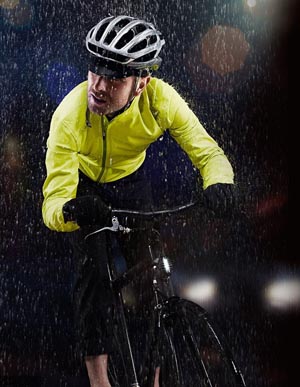Riding in the wet can be a mixed experience. If you've got the right equipment and riding skill, it can (sometimes) be more fun than a dry ride. However, if you're unprepared, under skilled, and a long way from home, it can soon turn to hell. You'll wish you took up table tennis instead!
So, to help you on your next wayward ride, we've got five riding tips and five equipment tips to keep you happy, hail or rain. Happy is good.
RIDING TIPS
1. SLIPPERY WHEN WET
When riding in the wet, avoid shiny surfaces. These offer no grip and are almost guaranteed to send you to the ground quite abruptly. On the road, marking paint and road markers are notoriously slippery when wet, while on the trails you'll need to steer clear of tree roots and rock faces.
2. SMOOTH STEERING
It is advisable to always steer smoothly in the wet. On a mountain bike trail, gravel offers surprisingly high levels of grip in the wet, but on the road it's a different story. If rounding a corner, or turning down a side street, slow down to at least half the speed you'd normally do. Slowly roll round the bend, then pedal once you've straightened up. Do not twitch or swerve the bike, and look ahead to better predict what's coming up.
3. BRAKING SAFELY
The one thing that loses serious amounts of performance in the wet - your brakes. Road brakes are almost useless in the wet, until that layer of water is skimmed off the rims during braking. When braking in the wet, begin slowing down around double the distance than when riding in the dry. You'll feel the brakes barely work and then steadily increase in effectiveness. This means it is advisable to scan the road ahead for any possible dangers that may require stopping quickly.
4. RIDE MORE SLOWLY
In line with brakes that barely work, it's highly advisable to analyse where you're riding and decide whether you should slow down. If a car or pedestrian were to appear in front of you (as they do), you'll have serious issues coming to a halt, even just slowing down enough to avoid injury. Just slow down enough to be in control, because even if your brakes do work, your skinny little tires sure won't...
5. TIRE PRESSURE
Something rarely considered by cyclists is tire pressure. If you're expecting a wet ride, reduce your tire pressures slightly. On the road, riding at 110psi is pointless if it can't allow the tire to deform and generate grip. Drop your tires to 90-100 PSI and enjoy the slightly improved grip, especially under braking.
EQUIPMENT

image: wired.co.uk
You can't buy happiness, unless it's in the form of bike gear! Here's a list of wet weather essentials or you could look at "Wet weather survival guide" for more detailed equipment choices.
1. WET WEATHER CLOTHING
It's always a good idea to have a quality rain jacket specific to riding, and some overshoes to keep your feet warm and dry. It might be worth considering some waterproof gloves if it's wet AND cold in your neck of the woods. It is important that the jacket is not only waterproof and lightweight, but also breathable so you don't end up wet with sweat.
2. BE VISIBLE
People hardly expect to see someone out cycling in horrid weather, so make yourself extra visible. Reflective rain jackets, excellent front and rear lights and good road positioning are crucial to your overall safety. Spend the money and look out for your own safety!
3. CLEAR LENSES
People often ride without glasses in the wet because it's too gloomy for tinted sunglasses. A set of clear lenses will protect your eyes in what is probably the most important time for glasses. The amount of road debris increases in the wet as your wet tires now pick up all the sand and dirt and throw it up into the air. You then ride into this airborne muck which is usually at face height. If you want to go for the best toys, invest in a pair of photochromatic lenses, which automatically change lense darkness based on outside lighting conditions.
4. WET WEATHER TIRES
If you're regularly riding in the wet it might be worth considering some weather specific tires. Wet weather tires might be slightly wider than normal as well as offering a more detailed tread pattern for added water displacement and grip. The rubber compound is usually slightly softer, offering better grip in cold conditions.

5. MUD GUARDS
Considered more for those keen on the dirt, mud guards have come a very long way. It's not uncommon to see a fancy road bike kitted up with low profile mud guards, especially during the wetter seasons. These mud guards are easily removed in seconds, so it's no problem to remove them when the weather improves. Check out what best suits your bike and choose which mounting method you prefer - semi-permanent or quick-mount.
With the help from this list, we hope your next wet ride is slightly more enjoyable. Sometimes it can't be avoided, as many commuters would know. Ride safely and get home in one piece so you can live to ride another sunny day.

RELATED ARTICLE:
5 things you must do after riding your road bike in the rain
When you ride your bike in the wet (as at some stage we all do), it will pay to spend a little time looking after your treasured steed post-ride. If you can resist the temptation to simply rack the bike in the garage and reach for a hot chocolate, a small time investment can... READ MORE



